
Mix Masters: Jonathan Castelli on Assembling Downtown
Jonathan Castelli on Assembling Downtown.
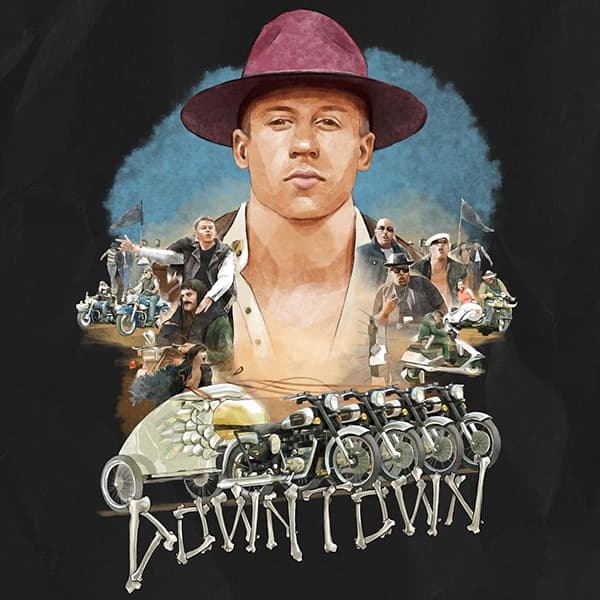
Artist: Macklemore & Ryan Lewis
Song: Downtown
Bruno Mars and Mark Ronson’s Uptown Funk was a very well orchestrated pastiche of ’80s funk. All the key elements were there — keytars, horns, low fisheye lenses and square-shouldered pastel sports blazers. But there was still a collected, serious side to the parody. Whether it was yammering on the phone while getting a perm or reading the paper while their shoes were shined, Mars and Ronson were getting down to the business of being funky.
Macklemore & Ryan Lewis don’t have to parody jack. Their songs and videos are too oddball to attract direct comparisons. Especially so on their latest hit, Downtown, which, on the face of it, could be read as a direct response to Uptown Funk, but is so much more bizarre.
Downtown’s chorus — top-lined by Foxy Shazam singer Eric Nally while riding a chariot pulled by Royal Enfield motorcycles — doesn’t come in until almost the two-minute mark. The verses — one-upping the anti-cool vibe of Thrift Shop by geeking out on mopeds — are made up of completely different sections, featuring not only Macklemore, but also rap pioneers Melle Mel, Kool Moe Dee and Grandmaster Caz. The song has echoes of both the ’70s and the early ’80s funk aped by Uptown Funk, and is almost entirely played on live instruments with prominent sax, trumpet, tuned percussion, and piano.
The song’s unconventional nature apparently also initially foxed its makers. Mixer Jonathan Castelli recalled, “Ryan called me and said they had been working on this song for two years, and they really needed fresh ears and perspective to help finish it. When my assistant, Ryan Nasci, and I listened to it for the first time, it sounded crazy. It was going to take a lot of work to make it feel like one cohesive concept. It sounded like four songs stitched together with transitions that made the sections sound completely different. There were no effects and the voices weren’t cutting through enough. The challenge was to make it sound like one whole piece so America would not be freaked out by it, as well as getting the voices to step out in front, make the whole song jump out of the speakers, and take it into the radio world.” A big job for an already unwieldy song.
GETTING DOWN TO IT
Castelli got the gig through Joshua ‘Budo’ Karp, a frequent collaborator with the Seattle duo he’d met at a writing session a few years ago. 18 months after that first meeting, Budo sent Castelli a text asking if he was up for mixing some Macklemore & Lewis material. He was hardly going to refuse, and got stuck into the mixes at his Mirrorball studio.
The uncertainty around exactly how to approach Downtown surprised Castelli. It was the fourth song he’d mixed for the album and the direction for the first three had been fairly clear. Although the duo weren’t exactly clear about the direction for Downtown, they did recognise that Castelli’s first mix wasn’t what they were after.
Castelli: “For my first mix, they had given me no direction, and when I sent it to them, I was very happy with it. Ben [Macklemore] contacted me and said, ‘Man! How did you get Eric’s voice to cut through in such a loud arrangement?’ But when Ryan [Lewis] called he said ‘Jon! I really like that mix, but it is completely the wrong direction! I like that warm, fat, more tube-like sound with extended bottom end, that you got on the other songs, but this song needs to be a little more natural sounding. It needs to be less EQ-ed in the low end, with more of a natural mid-range — more solid state.’
“I immediately knew what he meant. I love tube gear and tend to go for big fat bottom with subharmonic stuff and saturation. That worked on the first songs I mixed, but for this song he said, ‘do yourself a favour and go listen to Grandmaster Flash’. Finally he gave me some of the vision. If he’d given it to me earlier, I could have saved myself three days’ work! I had worked really hard on it, because I knew it was earmarked to be the first single from the album. Usually you can backtrack in a mix, but not with this song. I decided to start again. Downtown eventually turned into a two-week mix!”
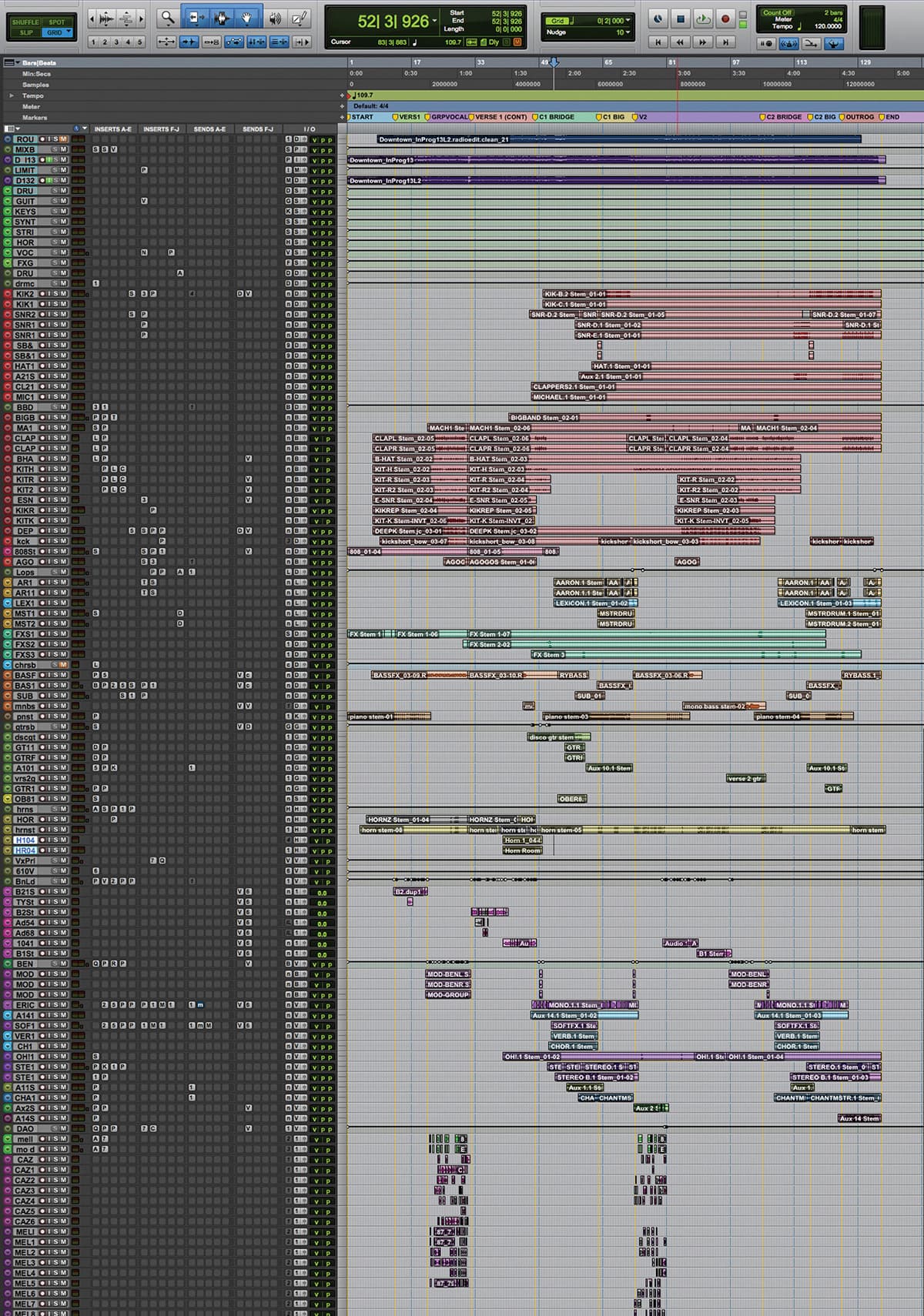



TWO-WEEK MIX
Two weeks for a mix sounds exorbitant, but Castelli said his mix for Downtown required a lot of fine-tuning because, “Ben and Ryan wanted to come out with a song that was unlike anything that had been released in the last 10 years. They’d had three No. 1s, and although they want to be successful, they really wanted to ‘wow’ people. High chart positions were less important. During one phonecall I said to Ryan that I saw the song as their response to Uptown Funk. Those guys are posh and living in uptown, whereas Downtown is more down-to-earth. He really liked that perspective.
“Specifically, instead of going for a big bass, R&B sound as with the first three songs, my challenge was for Downtown to sound more like a throwback to the seventies; more Neve and API than tube. Of course, it still needed enough bottom end and punch to sound current. The problem with my direction at that stage was more sonic, as I had already to some degree resolved the issues of Downtown — with rap verses and a clean chorus that transfers into something akin to classic rock — sounding very segmented. And, as Ben had indicated, I had managed to get the vocals to cut through. Bringing all that together was a big challenge. But I love being challenged!”
With so many pieces to assemble, more than ever, Castelli just took the time to listen. He “just listened to it for a good hour, soaking it in. For me mixing is about the journey and emotional connection you get with a song, not about what plug-ins I use. With other songs I might dive in right away, perhaps starting with getting the drums sounding good, but with a proper production and a great song like this I first listen to it a lot. When I have a connection with a song I tend to do less nitpicking and mix more from an overall picture. I do listen in solo mode at times, of course, but you have to be careful not to go down a rabbit hole, as your mix may start to sound disjointed. Everything has to fit, so I mix a lot with everything in.
“Like most people I generally start with the rhythm section, but in the case of Downtown I began the mix by focusing on Ben’s vocals. The drums were already in a good place, though perhaps not quite hitting as hard as they are now, so I focused on getting the vocals to be in charge, and then built everything around them as support. After Ben’s vocals I worked on Eric’s vocals in the chorus, and then the rest of the vocals, so they told me the story of what needed to happen between each section. After that I worked on the horns, followed by the drums and bass, really making sure the groove was solid; and then I worked the other instruments in.”
Somehow, Castelli managed to make everything work together. Over the course of five and a half minutes, the song takes you on a journey that is partly a throwback, definitely inventive, and, most importantly, fun. Pop songs aren’t typically this diverse, and Castelli’s mix makes those transitions effortless so you can just get down without a thought for the business of how it all came together.


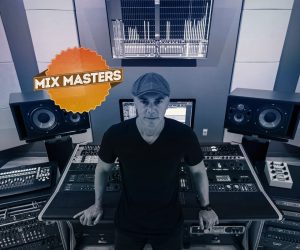

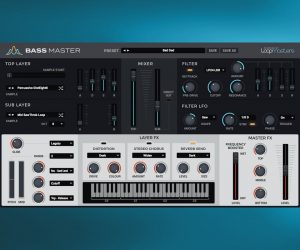





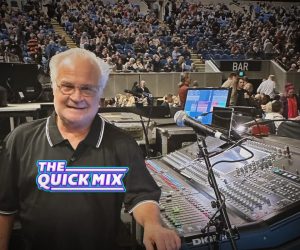





RESPONSES